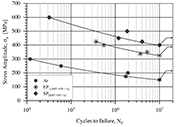E-Archive
Science Update
in Vol. 18 - January Issue - Year 2017
Shot Peening Improvements of the Fatigue Performance of Ultrafine-grained CuNi3Si1Mg for Electronic Applications

Figure 1: Microstructures of CuNi3Si1Mg

Figure 2: Surface layer properties after shot peening

Figure 3: Fatigue life variation (a = 400 MPa) after shot peening with various Almen intensities

Figure 4: S-N curves in rotating beam loading (R = -1)
In recent years, there has been an increasing demand for high-performance copper alloys in the automobile and computer industries with the miniaturization of electronic components. In the automobile industry, developing engineering has been focused on increasing formability, stress relaxation resistance, and fatigue performance based on the design of these copper-based equipments to obtain good reliability during the lifetime of the devices. High strength and medium-to-high electrical conductivity are considered essential characteristics for the use of copper alloys in electronic applications such as connectors, switches, relays, pins, lead frames, and high-strength wires. This report deals with the improvement of the fatigue performance of the age-hardened alloy CuNi3Si1Mg by means of swaging and shot peening. This alloy is broadly used for components in electronics and electrical applications.
The optical microstructures of CuNi3SiMg are illustrated in Figure 1 comparing the SHT condition (Fig. 1a) with conditions after swaging (Fig, 1b) and after additional heat treatment (Fig. 1c).
Shot peening was performed on hourglass-shaped rotating beam specimens using spherically-conditioned cut wire SCCW14 with various Almen intensities at full coverage.
Typical micro-hardness-depth distributions and residual stress profiles after shot peening are illustrated in Figure 2.
As seen in Figure 3, the fatigue life of shot-peened specimens illustrates a clear maximum at 0,25 mmA Almen intensity.
Further fatigue testing was done on shot-peened specimens using this optimum Almen intensity of 0,25 mmA (Fig. 4).
The experimental results show that swaging followed by aging plus shot peening can highly improve the fatigue performance of the as-received condition. This improvement is based on the microstructure refinement (Fig. 1), induced higher surface-layer hardness, and residual compressive stresses (Fig. 2).
This example of a material for innovative applications in electronics demonstrates that mechanical treatments such as swaging and shot peening will become increasingly important also in this area.
Institute of Materials Science and Engineering
TU-Clausthal-Zellerfeld, Germany
The authors would like to thank the Wieland Werke, Ulm for providing the tested alloy




























